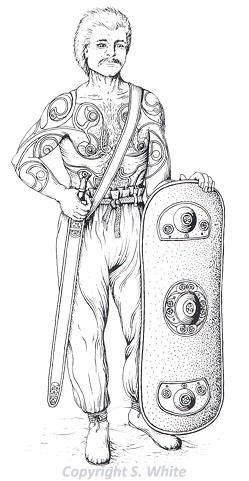In the Late Iron Age the people who lived in Norfolk were called the “Cenimagni” or the “Iceni” by the Romans. They wrote ECEN on their coins and have become known as the Iceni tribe. We do not have much evidence for how they lived. The Romans wrote some descriptions of them. There are some archaeological sites and finds that can help us to find out more.

The decorative detail on an Iron Age scabbard from Congham. NWHCM 1986.249:A (© NCC)
The Iceni were part of a larger group of people called the Celts. The Celts lived across Europe. They shared similar languages and ways of life but there were many different tribes. Each tribe was a little bit different. The Romans wrote about the Celts. They described them as fierce warriors. They went into battle naked and painted themselves blue. They spiked up their hair with lime and wore lots of gold jewellery. We are not sure how the Iron Age people painted themselves. They may have used the woad plant. This plant has yellow flowers but can be used to create a blue dye. The Celts may have carefully pricked their skin and rubbed the dye under the skin. Alternatively they may have just painted the dye straight onto the skin.

An Iron Age copper alloy cast vessel mount in the form of a bull's head from Kenninghall. (© NCC)
We don't know what types of design the Iceni used in their tattoos. They may have used similar swirly designs to those found on Iron Age terrets (NHER 33440) or other chariot fittings. They might have copied pictures of heads like the small model heads (NHER 25783, 25765 and 23321) that have been found in Norfolk. These may have come from the end of warrior's swords. They might have drawn fake torcs, like the gold ones found at Bawsey (NHER 3326) and Snettisham (NHER 1009), around their necks. They might have drawn pictures of animals like they did on their coins (NHER 1487) and vessel mounts (NHER 31324 and 29262).

A miniature Celtic-style head that dates from the Iron Age. (© NCC)
Would you like to be a fierce Iron Age warrior? You can use water based face paints to decorate your face.
Design your own Iron Age face painting

Drawing of an Iron Age Iceni warrior with tattoos on this chest and arms. (© Sue White.)
You will need: Water-based blue face paints
Hypo-allergenic baby wipes
Make up applicators, paintbrushes or your finger to apply the paints
Mirror
Face template
Blue pencil crayons or felt tips

Face template used for designing your own Iron Age painted face. (© NCC)
1. Print out the face template. Look at some of the Iron Age objects shown in the illustrations shown above and in the thumbnails below for some inspiration.
2. Draw the design for your face using your blue crayons or felt tips on the template. If you don’t want to paint your face you could design a tattoo for your hand or arm.
3. Using the mirror carefully copy your design onto your face. Alternatively you could ask a friend to paint the design.
Note
Check with an adult before painting your face. Be careful to avoid your eyes. Use water-based face paints. If you are allergic to certain ingredients check before you use the paints.
M. Dennis (NLA), July 2005.